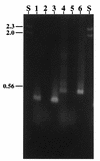Complementation analysis of the Dichelobacter nodosus fimN, fimO, and fimP genes in Pseudomonas aeruginosa and transcriptional analysis of the fimNOP gene region
- PMID: 9423871
- PMCID: PMC107890
- DOI: 10.1128/IAI.66.1.297-304.1998
Complementation analysis of the Dichelobacter nodosus fimN, fimO, and fimP genes in Pseudomonas aeruginosa and transcriptional analysis of the fimNOP gene region
Abstract
The causative agent of ovine footrot, the gram-negative anaerobe Dichelobacter nodosus, produces polar type IV fimbriae, which are the major protective antigens. The D. nodosus genes fimN, fimO, and fimP are homologs of the Pseudomonas aeruginosa fimbrial assembly genes, pilB, pilC, and pilD, respectively. Both the pilD and fimP genes encode prepilin peptidases that are responsible for cleavage of the leader sequence from the immature fimbrial subunit. To investigate the functional similarity of the fimbrial biogenesis systems from these organisms, the D. nodosus genes were introduced into P. aeruginosa strains carrying mutations in the homologous genes. Analysis of the resultant derivatives showed that the fimP gene complemented a pilD mutant of P. aeruginosa for both fimbrial assembly and protein secretion. However, the fimN and fimO genes did not complement pilB or pilC mutants, respectively. These results suggest that although the PilD prepilin peptidase can be functionally replaced by the heterologous FimP protein, the function of the PilB and PilC proteins may require binding or catalytic domains specific for the P. aeruginosa fimbrial assembly system. The transcriptional organization and regulation of the fimNOP gene region were also examined. The results of reverse transcriptase PCR and primer extension analysis suggested that these genes form an operon transcribed from two sigma70-type promoters located upstream of ORFM, an open reading frame proximal to fimN. Transcription of the D. nodosus fimbrial subunit was found to increase in cells grown on solid media, and it was postulated that this regulatory effect may be of significance in the infected footrot lesion.
Figures





Similar articles
-
Type IV fimbrial biogenesis is required for protease secretion and natural transformation in Dichelobacter nodosus.J Bacteriol. 2007 Jul;189(14):5022-33. doi: 10.1128/JB.00138-07. Epub 2007 May 18. J Bacteriol. 2007. PMID: 17513472 Free PMC article.
-
Identification of fimbrial assembly genes from Dichelobacter nodosus: evidence that fimP encodes the type-IV prepilin peptidase.Gene. 1995 Aug 8;161(1):21-6. doi: 10.1016/0378-1119(95)00264-7. Gene. 1995. PMID: 7642131
-
Cloning of an Aeromonas hydrophila type IV pilus biogenesis gene cluster: complementation of pilus assembly functions and characterization of a type IV leader peptidase/N-methyltransferase required for extracellular protein secretion.Mol Microbiol. 1996 Feb;19(4):857-69. doi: 10.1046/j.1365-2958.1996.431958.x. Mol Microbiol. 1996. PMID: 8820654
-
The molecular genetics of type-4 fimbriae in Pseudomonas aeruginosa--a review.Gene. 1996 Nov 7;179(1):147-55. doi: 10.1016/s0378-1119(96)00441-6. Gene. 1996. PMID: 8955641 Review.
-
Posttranslational processing of type IV prepilin and homologs by PilD of Pseudomonas aeruginosa.Methods Enzymol. 1994;235:527-40. doi: 10.1016/0076-6879(94)35168-6. Methods Enzymol. 1994. PMID: 8057924 Review.
Cited by
-
Regulation of type IV fimbrial biogenesis in Dichelobacter nodosus.J Bacteriol. 2006 Jul;188(13):4801-11. doi: 10.1128/JB.00255-06. J Bacteriol. 2006. PMID: 16788189 Free PMC article.
-
Type IV fimbrial biogenesis is required for protease secretion and natural transformation in Dichelobacter nodosus.J Bacteriol. 2007 Jul;189(14):5022-33. doi: 10.1128/JB.00138-07. Epub 2007 May 18. J Bacteriol. 2007. PMID: 17513472 Free PMC article.
References
-
- Bally M, Filloux A, Akrim M, Ball G, Lazdunski A, Tommassen J. Protein secretion in Pseudomonas aeruginosa: characterization of seven xcp genes and processing of secretory apparatus components by prepilin peptidase. Mol Microbiol. 1992;6:1121–1131. - PubMed
-
- Billington S J, Johnston J L, Rood J I. Virulence regions and virulence factors of the ovine footrot pathogen, Dichelobacter nodosus. FEMS Microbiol Lett. 1996;145:147–156. - PubMed
-
- Buchanan J M. The amidotransferases. Adv Enzymol Relat Areas Mol Biol. 1973;39:137–151. - PubMed
Publication types
MeSH terms
Substances
LinkOut - more resources
Full Text Sources

